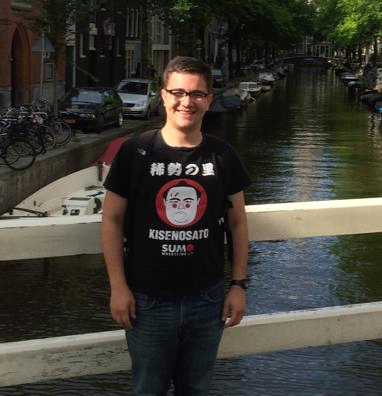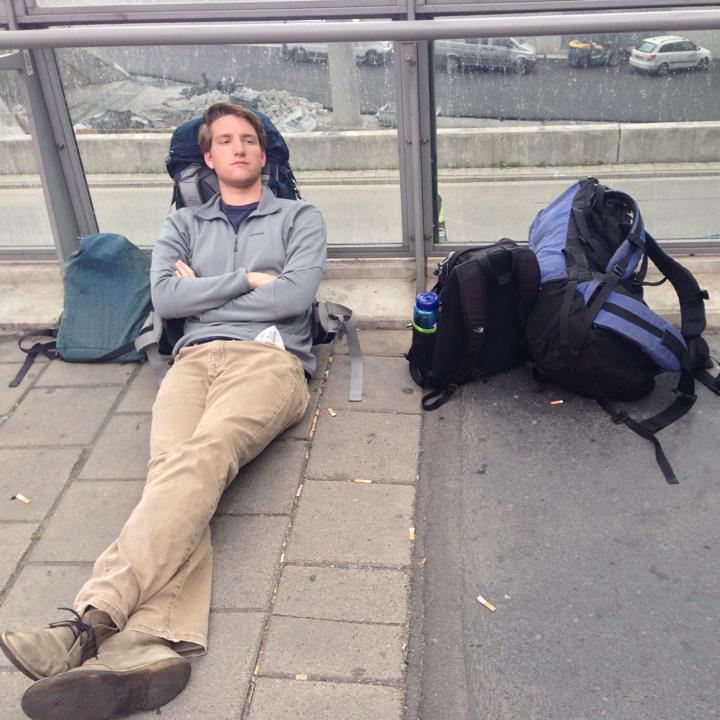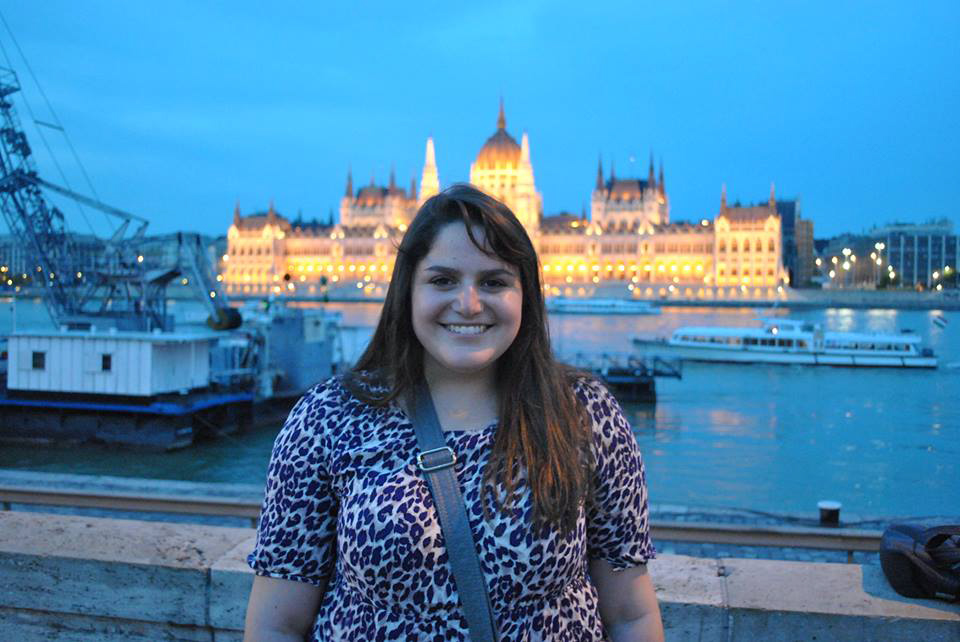The Traumatic Reconciliation of Memory and Reality
Evan Sweet, 2014 Caller-Zolondek Fellow, recounts memories from a long journey
Evan Sweet, 2014 Caller-Zolondek Fellow, recounts memories from a long journey
The minibus ride is uneventful; itʼs still quite early (we left at 9:00am) but the bus is full of all sorts of people, all going to the same destination, and listening to the same Polish Top 40 hits the bus driver is playing on the radio; oblivious or desensitized to the harrowing emotional journey his passengers will embark on after they leave his coach. Largely silent low conversations can be heard between travel companions. Sometimes laughter would escape the silence and an annoyed glare would be sent in their direction. Already a full three weeks into our journey across Europe visiting sites of the Nazi oppression and of former Jewish civilization, my travel partner, Jonathan, and I had become hyperaware that the presence of others frequently interrupted the importance or “sacredness” of the spaces we visited.
When one arrives in Krakow, offers of full package tours of Auschwitz are advertised by guides on the street as well as in every hostel
at check-in. At least 15 different flyers advertise trips for around 100 PLN (about $33). These groups provide transport, food, and guided tours of the camp; but also have you back on the bus at a comfortable hour regardless of your desire to stay longer. (Jonathan and I declined an organized tour in favor of an independent trip). Disembarking from the minibus, you must walk through a large parking lot full of private cars, but more notably chartered tourist busses. School children filed out of coaches, lined up in front of the main office to be counted by their teachers and pushed through turnstiles and into a staging area where tour leaders who will guide them through the campʼs horrors meet them. Independent travelers like Jonathan and myself are required to join guided tours to combat the overcrowding and large numbers of visitors to the death camps. You are quickly given a headset, and placed with a group of about 20 other individuals, with the only commonality between you and the others being language. Our group was a mix of Americans, some Australians and Brits; an unfriendly Canadian woman who had stayed at our hostel, two Japanese hipsters, and a mix of other English speakers. As far as Jonathan and I could tell, we seemed to be the only Jewish members of our tour group.
 The tour begins and the voice of our tour leader comes through the headphones that dangle around our necks. Although she is informative, very quickly I lower the volume and keep her as a somber voice in the back of my head. Walking towards the entrance of Auschwitz, I notice the faces of those returning from the tour are markedly different than the faces of those just entering. Clearly, walking through the camp changes one's emotional state: a profound experience for all who visit. Soon the tour arrives at the infamous gates “Arbeit Macht Frei” or “Work Will Set You Free” (Important: Many confuse this gate to the gate of Auschwitz-Birkenau, which has the rail line entering it and the “juden-ramp” where selection was done.) This is where the cameras first come out. Phones get pulled up as visitors begin framing the gate in front of the stark military barracks, which was the work camp of Auschwitz. Most people are taking photos just of the gate, but some travel partners take the gate with their companion in the foreground. I donʼt notice anyone taking a "selfie," but everyone knows how to be sneaky taking them. I did not take a photo of the gate, although the thought did cross my mind; but others taking photos of this important piece of Nazi oppression did not cross my mind as odd.
The tour begins and the voice of our tour leader comes through the headphones that dangle around our necks. Although she is informative, very quickly I lower the volume and keep her as a somber voice in the back of my head. Walking towards the entrance of Auschwitz, I notice the faces of those returning from the tour are markedly different than the faces of those just entering. Clearly, walking through the camp changes one's emotional state: a profound experience for all who visit. Soon the tour arrives at the infamous gates “Arbeit Macht Frei” or “Work Will Set You Free” (Important: Many confuse this gate to the gate of Auschwitz-Birkenau, which has the rail line entering it and the “juden-ramp” where selection was done.) This is where the cameras first come out. Phones get pulled up as visitors begin framing the gate in front of the stark military barracks, which was the work camp of Auschwitz. Most people are taking photos just of the gate, but some travel partners take the gate with their companion in the foreground. I donʼt notice anyone taking a "selfie," but everyone knows how to be sneaky taking them. I did not take a photo of the gate, although the thought did cross my mind; but others taking photos of this important piece of Nazi oppression did not cross my mind as odd. My opinion of the appropriate use of photography steadily changed as our tour progressed. The first portion of the tour went through the official State exhibit, which appears to have been created in the 1950ʼs at the latest. The exhibits are largely mass collections of objects in large glass cases: thousands of suitcases labeled with family names piled on top of each other, a swimming pool sized mass of pots and pans, a pile of wire framed glasses, all brought by Jews and others killed in the campʼs gas chambers. Jonathan points out how one canʼt really understand the vastness of the Nazi tragedy by looking at these cases upon cases of personal items because they are more like the “guess the number of marbles” charity games, the number is so abstract and vast it becomes inconceivable, precision is not the goal, but a gut feeling tells you how many marbles there are. In these exhibits, cameras are again pulled out and these vast collections of childrenʼs dolls are digitally catalogued, even while they lack context, as they are purely a fraction of the real number of glasses, which no longer have eyes to serve.
Only in one of these exhibits is photography banned. It's a narrow hallway on either side full of dirty/dark blonde to black hair, shorn from mostly Jewish women as they entered the camps and sent to Germany for use in cloth manufacturing. As this was the hair of victims, it was deemed sacred enough to be preserved from the photographic lens. Interestingly, this distinction acknowledges that there is a context for photography and that in certain places photography should be limited or banned.
The Metaphor: A Manuscript
Zolondek A&S Holocaust Scholarship fellow Jonathan Sarfin shares an excerpt of a work composed during his summer of research and learning
A sea of corpses. Or, no, simply wave after wave of shorn hair swallowing up the beach. Coral reefs, suitcases stacked haphazardly one on top of the other, leather shoes dart like fish among them, and oh, it is so quiet here. It was, as always, a long fifteen minutes…
Those are the words of a fragment of a document written by a Sonderkommando that I executed this morning, prisoner number 304805, sentenced to death as part of camp-wide reprisals due to the activity of camp resistance. Twice I was unlucky – first, to have been picked to carry out the judgment and second, to have been ordered to oversee the disposal of the body. It is my own fault, for we choose our own misfortunes in this world, but I still feel unjustly burdened.
The execution of a prisoner is not uncommon, and, in fact, it was a fine morning – the sun was out and there were only a few clouds, wisps, in the sky. Roll call went quickly. The man did not put up a struggle as my comrades selected him from the mass of striped shirts which clothe empty slaves. He walked forwards, slow, strong, towards the wall. He began to speak, but I could not make out what he was saying; his gait, which I first perceived as deliberate but relaxed was perhaps meant to prolong his time in hell. My comrade struck him with the rifle butt. The prisoner opened his mouth but did not utter a cry as he fell to the ground. My comrade cursed him and then tried to drag him by the collar. The man, like some sort of watery mirage, returned to his feet and resumed his walk, and to me, he was shimmering, nearly translucent. His mouth was still open as though he was crying out in pain or transfixed by an unassailable horror, but he continued to approach me. This man was probably fifty and I think that once he must have been quite prosperous, for his body looked like fat and meat had been shaved off him. Now he was only bones and a round, protuberant stomach.
I chambered a bullet. He looked at me with his open mouth and I remember shivering, suddenly cold. I saw in my mind an image of a field, covered with snow, it must have been nearly five meters of snow, and I could see the wind blowing and resettling the top layer of snow, but yet it never looked any different. The plants were choking and dying, slowly, but they were helpless underneath the sea of snow.
I was engrossed in this image even as I remained aware of the prisoner kneeling down. The sound of his mouth closing dissolved the snow and the plants; the whole image floundered and disappeared. He turned his head and looked up at me and I, faithfully and without blinking, met his gaze. He turned away and began to speak. At first I thought he was saying the Shema, which I know by heart now, having heard it countless times, but as I began to recite it with him, as is my custom, I realized I was mistaken. Of the words he uttered, which were quiet enough so only I, I am convinced, could hear, I only recognized three: adonai, Yahweh, and gott, and only the last one is in my own tongue; it elucidated all his other words. My ears grew very warm and my heart began to beat rapidly. He continued speaking as I leveled the gun at him, but I heard a little gasp, a minute pause, as the muzzle touched the base
of his skull.
 He spoke faster and faster, but more quietly, until I could barely tell that words were leaving his mouth. I turned to the commandant, who gave a curt nod. What was going through my mind in that moment? Now I cannot remember, but I suspect that it was a banal nothing. I pulled the trigger.
He spoke faster and faster, but more quietly, until I could barely tell that words were leaving his mouth. I turned to the commandant, who gave a curt nod. What was going through my mind in that moment? Now I cannot remember, but I suspect that it was a banal nothing. I pulled the trigger.There was a flash of light and for an instant I ceased to exist. I felt my shoulders tense as though I was carrying a great load and I heard the prisoner whisper a word, one last word, with empyreal serenitude. The word took his life with him as it escaped into unreality. The light was gone and his lifeless corpse pitched forward, brainless, into the cobblestones, which, as a last indignity, shattered his nose. A great noise issued from hundreds of mouths, and I could not tell whether it was one of joy for the one who had served his plenitude and then escaped, or one of misery, a lamentation. Several rounds from a machine gun cut short the burst; I am still unclear about its nature.
The commandant signaled for the dismissal of the prisoners and the dispersed like a river of gray mud. The Sonderkommandos remained still; there were no trains arriving until the afternoon. I stepped over the body, the capacious stomach which dwarfed the rest, even in shrunken death, and called for two of the Sonderkommandos to take the body to the crematorium. The two thin, tall men with sunken eyes that were nearly black struggled to pick up the body. At first, the dragged him by the legs across the square, leaving a trail of blood. I did not like this. I told them to carry him. They hoisted him on their shoulders, a cold arm slung on each manʼs shoulder, as though he were still alive, merely wounded.
We walked towards the crematorium. I was fortunate that one of the Sonderkommandos collapsed – a brief respite for me. As I screamed at them, they began to walk again, but they did not have the strength to carry him – instead they dragged him, one holding his arms and the other, his legs, so that prisoner 304805 bent like a misshapen crescent, his swollen belly dragging on the ground. We walked very slowly, I could not help it – a grotesque procession, Sonderkommando, corpse, Sonderkommando, me; in my mind, an Arabian caravan navigating an infinite labyrinth, up to the knees in sand; me, bent double by the weight of my pack, carrying a secret treasure plundered from a neighboring kingdom; I do not even know what it is.
Touring Jewish History
Zolondek A&S Holocaust Scholarship recipient Sibel Solagan remembers her favorite parts of a summer spent traveling and absorbing cultures
This past June, I was absolutely honored to receive the Zolondek A&S Holocaust Scholarship in order to study about the Holocaust. The travel grant allowed me to visit five main cities: Paris, Amsterdam, Berlin, Vienna, and Prague. In each city, I was required to visit certain monuments, museums, and synagogues with many sharing information about the horrors of the Holocaust.
The most surprising thing that I learned in my trip was how a majority of the synagogues in Berlin werenʼt necessarily destroyed during World War II, but rather they were simply taken down to make more living space for the growing population after the war. Many memorials commemorating these synagogues are scattered throughout Berlin. I was able to visit the New Synagogue, which was one of the only synagogues to survive the war. Today, however, it has been turned into a museum of Jewish history in Berlin.
 In addition, I was impressed particularly with Amsterdamʼs Dutch Resistance Museum. The Dutch Resistance Museum was intriguing simply because unlike other sites, it gave a glimmer of hope for its visitors to see how a people tried to fight against the Nazi oppression. This museum really focused on the questions that Dutch citizens were asking themselves at each step of German occupation throughout Holland. What was most fascinating was the innovation of the Dutch people to try to protect their friends, neighbors, and family from the atrocities that possibly lay ahead. Dutch citizens worked hard to create underground newspapers that were produced in their own homes to spread information among the resistance movement. Others recreated identical fake identification cards for their fellow Jewish citizens. For me, remembering that this was a time when todayʼs technology was nonexistent made all of the work even more impressive.
In addition, I was impressed particularly with Amsterdamʼs Dutch Resistance Museum. The Dutch Resistance Museum was intriguing simply because unlike other sites, it gave a glimmer of hope for its visitors to see how a people tried to fight against the Nazi oppression. This museum really focused on the questions that Dutch citizens were asking themselves at each step of German occupation throughout Holland. What was most fascinating was the innovation of the Dutch people to try to protect their friends, neighbors, and family from the atrocities that possibly lay ahead. Dutch citizens worked hard to create underground newspapers that were produced in their own homes to spread information among the resistance movement. Others recreated identical fake identification cards for their fellow Jewish citizens. For me, remembering that this was a time when todayʼs technology was nonexistent made all of the work even more impressive. Overall, this trip was a wonderful learning experience. The places that I saw and the people that I met in my travels will forever stay with me. I hope that by partaking in this experience, I will be able to continue to educate others about the Holocaust and that I can be motivated by the words of one of the most innocent victims of the Holocaust:
“How wonderful it is that nobody need wait a single moment before starting to improve the world.” – Anne Frank
